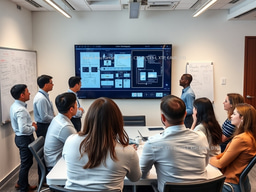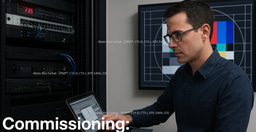The Importance of Proper Cooling Systems for External LED Screens in Hot Weather Environments

External LED Video Wall screens have become an integral part of modern architectural and entertainment landscapes, serving a wide range of applications, from digital billboards to outdoor advertising, stadium displays and large-scale public information systems.
These screens offer high brightness, vibrant colors and the ability to display dynamic content, making them ideal for use in various environments. However the performance and longevity of these screens can be significantly impacted by external factors, particularly extreme weather conditions. In hot weather environments, providing a proper cooling system is not just recommended but essential to ensure the reliable operation of these installations.
Understanding the Impact of Heat on LED Screens
LED technology is widely recognized for its energy efficiency and long lifespan. However, like all electronic devices, LED screens generate heat during operation. This heat, if not properly managed, can lead to a range of issues, including reduced brightness, color shifts, shortened lifespan and even complete failure of the screen. The impact of heat is further exacerbated in hot weather environments where ambient temperatures can reach extreme levels.
- Thermal Stress: Prolonged exposure to high temperatures can cause thermal stress on the LED modules, leading to premature aging of components. This can result in a gradual decline in performance, such as reduced brightness and color accuracy.
- Degraded Image Quality: Excessive heat can cause the electronic components within the LED screen to malfunction, leading to image artifacts such as flickering, ghosting, or even complete image loss.
- Component Failure: High temperatures can accelerate the degradation of key components, such as power supplies and driving circuits, leading to increased failure rates and costly maintenance.
- Safety Risks: Overheating can pose safety risks, including the potential for fire hazards if the cooling system fails or is inadequate.
Given these risks, it is crucial to implement a proper cooling system that can effectively manage the heat generated by external LED screens, especially in hot weather environments.
We can refer to some AVIXA Standards and best practices for the design and installation of AV systems, including external LED screens. These standards emphasize the importance of environmental considerations, particularly in challenging weather conditions.
- Environmental Assessment and System Design:
- Site Analysis: Before installation, conduct a thorough site analysis to assess environmental factors, including ambient temperature, humidity, direct sunlight exposure, and wind patterns. This analysis should inform the design of the cooling system.
- Heat Load Calculation: Calculate the total heat load of the LED screen, considering both the internal heat generated by the electronic components and the external heat from the environment. This will help determine the capacity of the cooling system required.
- Active Cooling Solutions:
- Forced Air Cooling: One of the most common active cooling solutions involves the use of fans or blowers to circulate air within the LED screen enclosure. The fans draw cooler air from the environment and expel hot air, preventing heat buildup.
- Air Conditioning Units: For large installations or environments with extremely high temperatures, dedicated air conditioning units may be necessary. These units can maintain a consistent internal temperature, ensuring optimal performance of the LED screen.
- Liquid Cooling Systems: In some cases, liquid cooling systems may be employed. These systems use a coolant to absorb heat from the LED modules, which is then circulated to a radiator or heat exchanger to dissipate the heat.
- Passive Cooling Solutions:
- Heat Sinks: Heat sinks are metal components designed to absorb and dissipate heat from the LED modules. They are often used in conjunction with active cooling systems to enhance overall thermal management.
- Thermal Insulation: Proper insulation of the LED screen enclosure can help minimize heat transfer from the external environment. Insulation materials should be selected based on their thermal conductivity and durability.
- Protective Enclosures:
- Weatherproof Enclosures: The LED screen should be housed in a weatherproof enclosure that protects against dust, moisture and UV radiation. The enclosure should also include ventilation features that allow for proper airflow while preventing the ingress of contaminants.
- Sunshades and Louvers: To reduce direct exposure to sunlight, consider incorporating sunshades or louvers into the design of the enclosure. These features can help reduce the external heat load on the screen.
- Monitoring and Maintenance:
- Temperature Monitoring: Install temperature sensors within the LED screen enclosure to continuously monitor the internal temperature. These sensors should be connected to an alert system that notifies operators if the temperature exceeds safe limits.
- Regular Maintenance: The cooling system, including fans, filters, and air conditioning units, should be regularly inspected and maintained to ensure optimal performance. This includes cleaning or replacing filters, checking coolant levels, and verifying the operation of fans and blowers.
- Redundancy and Fail-Safes:
- Redundant Cooling Systems: For critical installations, consider implementing redundant cooling systems. This ensures that if one system fails, the backup system can take over, preventing overheating and potential damage.
- Fail-Safe Mechanisms: Incorporate fail-safe mechanisms such as automatic shutdown or reduced brightness mode if the temperature exceeds critical levels. This helps protect the LED screen from damage and extends its lifespan.
Conclusion
In hot weather environments, the importance of providing a proper cooling system for external LED screens cannot be overstated. By adhering to AVIXA standards and best practices, AV professionals can design and install cooling systems that effectively manage heat, ensuring the longevity, reliability and performance of LED screens. A well-designed cooling system not only protects the investment in LED technology but also enhances the overall user experience, delivering consistent and high-quality visual content in even the most challenging conditions. As the demand for external LED screens continues to grow, particularly in regions with extreme climates, the implementation of robust cooling solutions will remain a critical aspect of successful AV installations.
-
Xchange Advocates are recognized AV/IT industry thought leaders and influencers. We invite you to connect with them and follow their activity across the community as they offer valuable insights and expertise while advocating for and building awareness of the AV industry.
Recommended Content
LetsTalkAVbyAlexis Series: Episode 4 : Design Begins With People: Engineering AV Systems Around Real End-User Requirements

LetsTalkAVbyAlexis Series : Episode 2: Network & AV Convergence (AVoIP)





Please sign in or register for FREE
If you are a registered user on AVIXA Xchange, please sign in